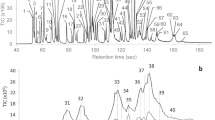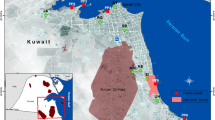Abstract
Two multiresidue methods were developed to determine pesticides in air collected in California. Pesticides were trapped using XAD-4 resin and extracted with ethyl acetate. Based on an analytical method from the University of California Davis Trace Analytical Laboratory, pesticides were detected by analyzing the extract by gas chromatography–mass spectrometry (GC-MS) to determine chlorothalonil, chlorthal-dimethyl, cycloate, dicloran, dicofol, EPTC, ethalfluralin, iprodione, mefenoxam, metolachlor, PCNB, permethrin, pronamide, simazine, trifluralin, and vinclozolin. A GC with a flame photometric detector was used to determine chlorpyrifos, chlorpyrifos oxon, diazinon, diazinon oxon, dimethoate, dimethoate oxon, fonophos, fonophos oxon, malathion, malathion oxon, naled, and oxydemeton. Trapping efficiencies ranged from 78 to 92 % for low level (0.5 μg) and 37–104 % for high level (50 and 100 μg) recoveries. Little to no degradation of compounds occurred over 31 days; recoveries ranged from 78 to 113 %. In the California Department of Food and Agriculture (CDFA) method, pesticides were detected by analyzing the extract by GC-MS to determine chlorothalonil, chlorpyrifos, cypermethrin, dichlorvos, dicofol, endosulfan 1, endosulfan sulfate, oxyfluorfen, permethrin, propargite, and trifluralin. A liquid chromatograph coupled to a MS was used to determine azinphos-methyl, chloropyrifos oxon, DEF, diazinon, diazinon oxon, dimethoate, dimethoate oxon, diuron, EPTC, malathion, malathion oxon, metolachlor, molinate, norflurazon, oryzalin, phosmet, propanil, simazine and thiobencarb. Trapping efficiencies for compounds determined by the CDFA method ranged from 10 to 113, 22 to 114, and 56 to 132 % for 10, 5, and 2 μg spikes, respectively. Storage tests yielded 70–170 % recovery for up to 28 days. These multiresidue methods represent flexible, sensitive, accurate, and cost-effective ways to determine residues of various pesticides in ambient air.
Similar content being viewed by others
References
Egea Gonzalez, F. J., Mena Granero, A., Glass, C. R., & Garrido Frenich, A. (2004). Screening method for pesticides in air by gas chromatography/tandem mass spectrometry. Rapid Communications in Mass Spectrometry, 18(5), 537–543. doi:10.1002/rcm.1359.
Foreman, W. T., Majewski, M. S., Goolsby, D. A., Wiebe, F. W., & Coupe, R. H. (2000). Pesticides in the atmosphere of the Mississippi River Valley, part II—air. Science of the Total Environment, 248(2–3), 213–226.
Hall, G. L., Mourer, C. R., Shibamoto, T., & Fitzell, D. (1997a). Development and validation of an analytical method for naled and dichlorvos in air. Journal of Agricultural and Food Chemistry, 45(1), 145–148.
Hall, G. L., Mourer, C. R., & Shibamoto, T. (1997b). Development of determination method for carbofuran and oxydemeton-methyl in ambient air. Journal of Agricultural and Food Chemistry, 45(11), 4347–4350.
LeNoir, J. S., McConnell, L. L., Fellers, G. M., Cahill, T. M., & Seiber, J. N. (1999). Summertime transport of current-use pesticides from California’s Central Valley to the Sierra Nevada mountain range, USA. Environmental Toxicology and Chemistry, 18(12), 2715–2722.
Royce, B. R., Longley, K. E., & Gump, B. H. (1993). Airborne concentrations of oxydemeton-methyl and dioxydemeton-methyl in Salinas Valley from sampling conducted August 31 to October 9, 1992. Air Resources Board Contract no. A032-094. Fresno: Engineering Research Institute, California State University.
Seiber, J. N., McChesney, M. M., & Woodrow, J. E. (1989). Airborne residue resulting from use of methyl parathion, molinate and thiobencarb on rice in the Sacramento Valley, California. Environmental Toxicology and Chemistry, 8(7), 577–588.
Wofford, P., Segawa, R., Brattesani, M., Schreider, J., & Powell, S. (2003). Ambient air monitoring for pesticides in Lompoc, CA, Volume 3: Multiple pesticides. Report #EH03-02, Sacramento: CDPR, Cal/EPA.
Wofford, P., Segawa, R., Schreider, J., Federighi, V., Neal, R., & Brattesani, M. (2013). Community air monitoring for pesticides. Part 3: using health-based screening levels to evaluate results collected for a year. Environmental Monitoring and Assessment (in press).
Acknowledgments
The University of California Davis Trace Analytical Laboratory (J. Engebretson, B. Hung, G. Hall, and J. McFarland), under the direction of Chuck Mourer at the time of this project, would like to thank Randy Segawa and Pam Wofford at the California Department of Pesticide Regulation and the Lompoc Interagency Work Group for funding and support of this project.
Author information
Authors and Affiliations
Corresponding author
Rights and permissions
About this article
Cite this article
Hengel, M., Lee, P. Community air monitoring for pesticides—part 2: multiresidue determination of pesticides in air by gas chromatography, gas chromatography–mass spectrometry, and liquid chromatography–mass spectrometry. Environ Monit Assess 186, 1343–1353 (2014). https://doi.org/10.1007/s10661-013-3395-9
Received:
Accepted:
Published:
Issue Date:
DOI: https://doi.org/10.1007/s10661-013-3395-9




